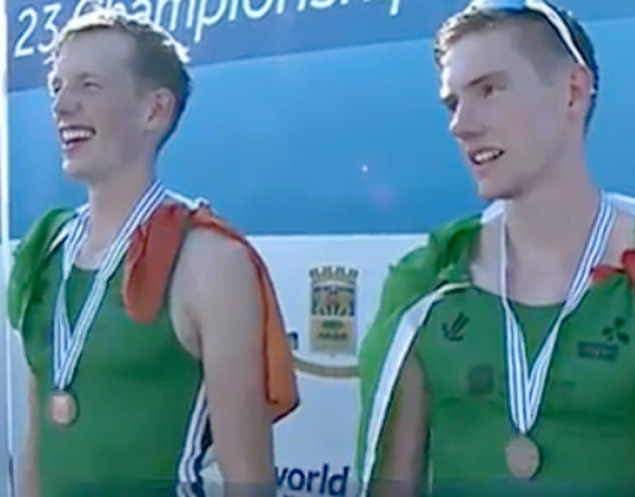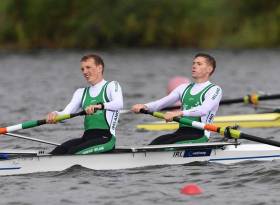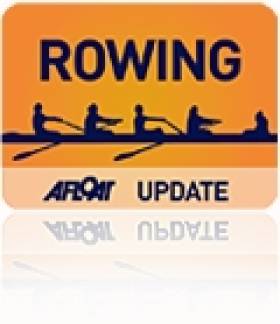Displaying items by tag: Lightweight Pair
#Rowing: Ireland’s David O’Malley and Shane Mulvaney took a bronze medal at the World Rowing Under-23 Championships in Plovdiv, Bulgaria today. Italy won a tense race. Turkey led early on, but Italy and Ireland came through fast. With 500 metres to go, Italy had taken the lead with Ireland and Turkey just behind. In the final quarter, Italy secured first with Turkey just rebuffing Ireland to take the silver. Mulvaney and O’Malley had taken bronze a year after just missing out on a medal.
 David O'Malley and Shane Mulvaney with Bronze Medal at World Under-23
David O'Malley and Shane Mulvaney with Bronze Medal at World Under-23
World Under-23 Championships, Plovdiv, Bulgaria (Irish interest)
Men
Lightweight Pair – A Final: 1 Italy 6:33.05, 2 Turkey 6:36.70, 3 Ireland (S Mulvaney, D O’Malley) 6:37.63; 4 Britain 6:45.33, 5 France 6:46.74, 6 Denmark 6:53.36.
Lightweight Double Sculls – Semi-Finals (First Three to A Final; rest to B Final)
Semi-Final One: 1 Denmark 6:18.69, 2 Italy 6:21.85, 3 Germany 6:23.22.
Semi-Final Two: 1 Canada 6:19.88, 2 Spain 6:20.66, 3 South Africa 6:21.69; 4 Ireland (F McCarthy, J McCarthy) 6:22.56, 5 Britain 6:23.77, 6 Poland 6:42.15.
Brilliant Win Sends Ireland Pair Into World Rowing Final
#Rowing: Ireland’s David O’Malley and Shane Mulvaney became the country’s first A Finalists at the World Rowing Championships in Rotterdam today. The under-23 lightweight pair won their semi-final with almost three seconds to spare. The two UCD men took over from early leaders Turkey by half way and then left the rest behind. Turkey finished second and the United States ousted Canada to take the third A Final spot.
World Rowing Championships, Rotterdam (Irish interest; selected results)
Men
Under-23 Lightweight Pair - Semi-Finals (First Three to A Final; rest to B Final) - Semi-Final One: 1 Greece 6:39.18, 2 Switzerland 6:40.01, 3 China 6:44.52. Semi-Final Two: 1 Ireland (S Mulvaney, D O’Malley) 6:46.20, 2 Turkey 6:49.11, 3 United States 6:50.75.
Tenth Places for Two Ireland Crews at World Rowing Championships
#ROWING: Ireland’s men’s lightweight pair finished fourth in their B Final, 10th overall, at the World Rowing Championships in Amsterdam today. China won in a fast time in tailwind conditions, with Bulgaria and the Netherlands battling each other and finishing second and third. Ireland’s Niall Kenny and Mark O’Donovan were fifth through the middle stages but won their own battle with Austria to take a clear fourth.
The women’s four of Marie O'Neill, Emily Tormey, Aifric Keogh and Barbara O'Brien were fourth in their B Final, behind the Netherlands, who won impressively from Italy, with Germany third.
World Rowing Championships, Amsterdam, Day Six (Irish interest, selected results)
Men
Lightweight Pair – B Final (Places 7 to 12): 1 China (Zhenwei Hou, Fangbing Zhang) 6:28.29, 2 Bulgaria 6:30.40, 3 Netherlands 6:31.01, 4 Ireland (M O’Donovan, N Kenny) 6:34.06, 5 Austria 6:37.65, 6 Chile 6:43.01.
Women
Four – B Final (Places 7 to 10): 1 Netherlands 6:28.95, 2 Italy 6:35.51, 3 Germany 6:37.90, 4 Ireland (M O’Neill, E Tormey, A Keogh, B O’Brien) 6:43.62.
Lightweight Double Sculls – C Final (Places 13 to 18): 1 Russia (D Stepochkina, O Arkadova) 6:58.21, 2 Ireland (C Lambe, D Walsh) 7:00.11, 3 Denmark 7:03.49, 4 Switzerland 7:03.51, 5 Belarus 7:09.08, 6 Greece 7:14.20.































































